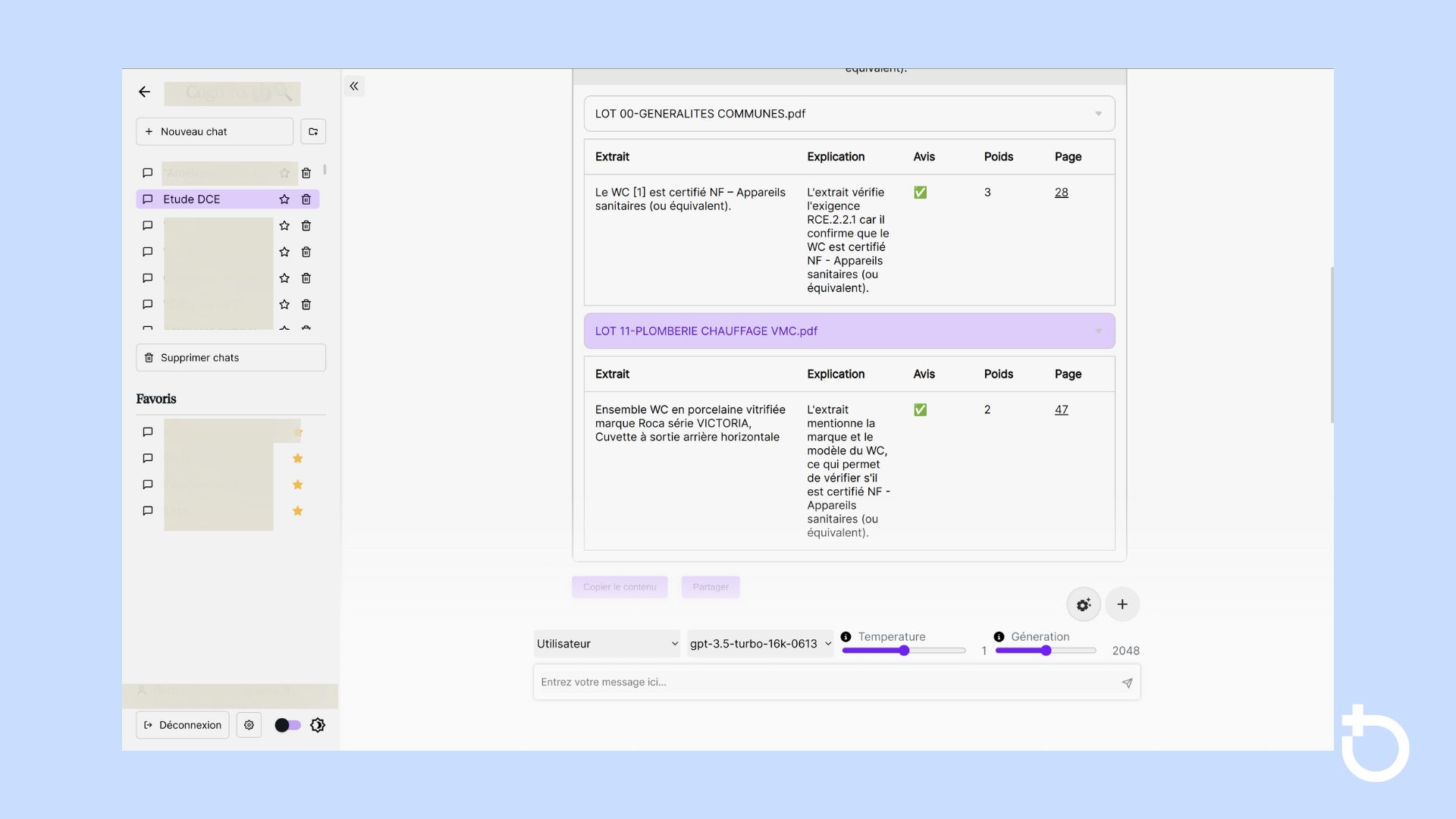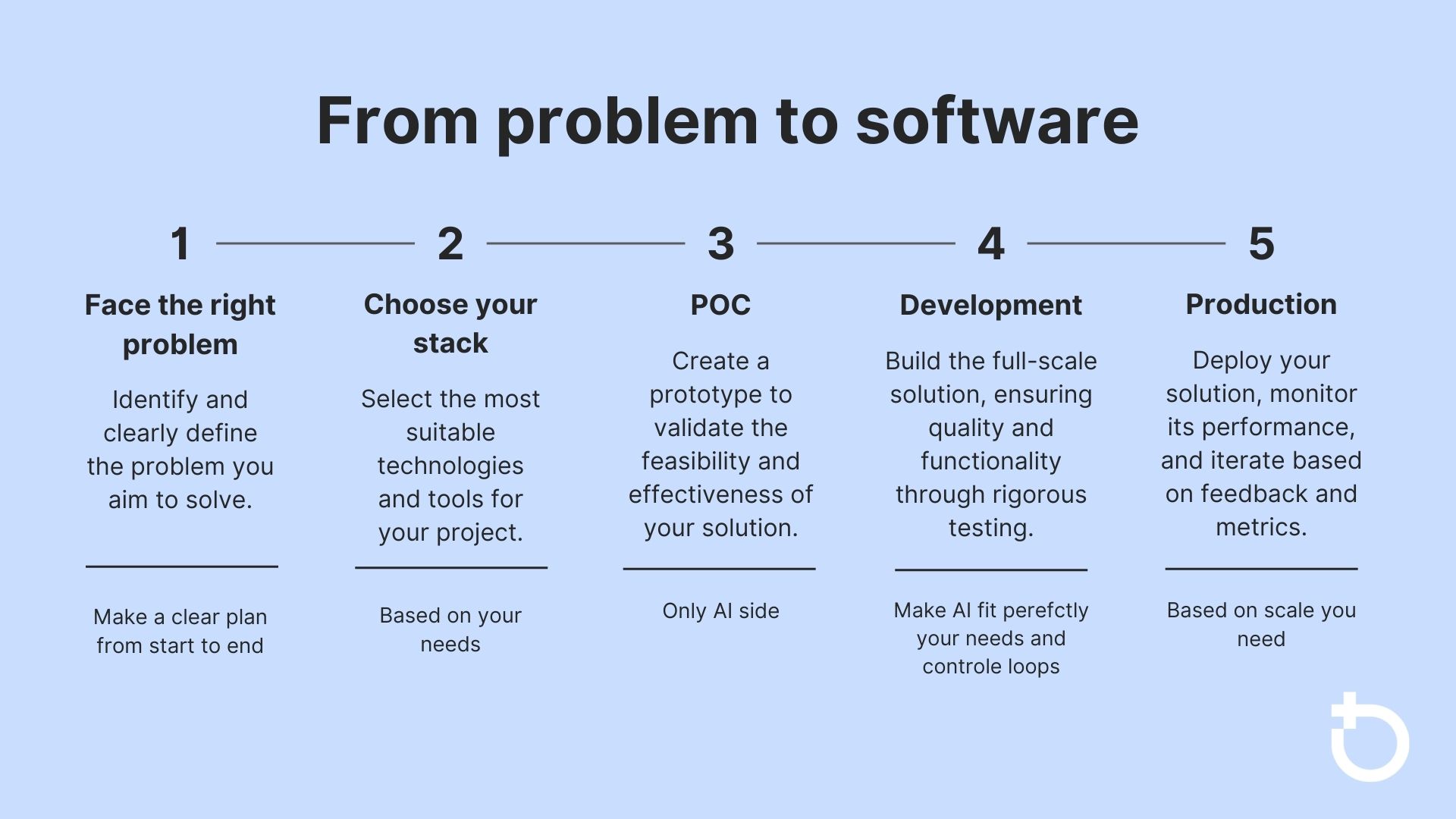Case overview
AI drastically accelerates the verification of construction standards and unlocks data potential.
In the realm of audit and compliance for building construction, the meticulous scrutiny of Technical Specification Documents (« CCTP », in French) presents a formidable challenge. Companies grapple with extensive documents, each containing up to 2000 pages and approximately 600 unique norms or requirements that necessitate thorough verification. This task is especially daunting due to the unstructured and diverse nature of CCTPs, making the process highly labor-intensive. Beyond the immediate hurdle of norm verification, the industry contends with broader issues, such as reducing the steep technical training requirements for new hires and minimizing errors to bolster productivity.
Moreover, the stringent COFRAC certification laws further complicate matters by limiting the degree to which automation can supplant manual verification. Addressing this multifaceted challenge, an AI-powered Proof of Concept (POC) was conducted, making it possible to achieve significant progress. The solution not only streamlines the norm verification process but also harnesses the untapped potential of internal data across various operational facets. By integrating a chatbot, AI extends its utility, offering a better support for managers (through seamless navigation of internal company data) and simplifying procedures for new employees. This innovative approach doesn’t just aim to revolutionize CCTP verification; it helps to reimagine the utilization of internal data, creating a robust framework that enhances every level of the organization’s operations.

The Brief
The main objective of the project was to improve team productivity during the assessment of technical specification (CCTP), a costly process that consumed 4 man-days for each analysis. This verification task is central to the business, pivotal for ensuring compliance and maintaining high quality standards. The challenge was to harness AI technology to streamline this essential yet cumbersome process, in order to significantly reduce the time and resources required. Beyond improving efficiency in CCTP verification, the brief also envisioned leveraging AI to revalue and repurpose internal data. By mastering the nuances of CCTP verification, the project aimed to not only speed up the verification process but also, in a second phase, to facilitate the creation of these documents. This approach promises to enhance operational efficiency and establish a scalable model for adapting to various business needs, thus creating new opportunities for innovation and growth within the company.


Our Approach
Our approach to transforming the verification process of Technical Specification Documents (CCTPs) began with a meticulous audit to identify processes that could be subject to automation. This initial step involved:
- Problem identification: conducting a thorough analysis to understand the complexities and bottlenecks in the existing verification process.
- Automation potential: assessing which parts of the process could be automated, considering both the technological feasibility and compliance with COFRAC certification laws.
Following the audit, we have established a technical strategy, prioritizing solutions that offered scalability, efficiency, and accuracy:
- Technology selection: selecting AI and machine learning technologies for their potential to handle unstructured data and complex pattern recognition.
The next phase was the development and testing of a Proof of Concept (POC):
- POC development: creating a prototype to demonstrate how AI could streamline the verification process, focusing on reducing the manual effort required and minimizing errors.
- Beta testing: engaging with a group of beta testers to gather feedback, refine the AI algorithms, and ensure the solution was intuitive and user-friendly.
With positive results from the POC, we moved on to full-scale roll out:
- Full-Scale deployment: expanding the solution to include a comprehensive chatbot for assisting with internal company data, supporting supervisors, and helping new employees with procedures.
- Iterative improvement: implementing a feedback loop from beta testers to continuously refine the solution, ensuring it met the needs of end-users and complied with industry standards.
Throughout this process, we also focused on:
- User experience design: ensuring the graphical interface was not only intuitive but also enhanced the user’s interaction with the technology.
- Compliance and data privacy: upholding strict data privacy standards and ensuring all solutions were in line with regulatory requirements.
- Scalability and expansion: exploring opportunities to apply the technology to other areas, such as generating CCTPs, thereby adding value to internal data and know-how.
By adopting this comprehensive approach, we aimed to not only revolutionize the verification process but also demonstrate the broader applicability of AI within the sector, setting a new standard for efficiency and innovation.


The Results
The implementation of our approach yielded significant results, transforming the operational efficiency and data utilization within the company. The key outcomes included:
- Increased productivity: the most striking improvement was the reduction in time required for CCTP verification. We successfully reduced the verification time from 4 man-days to less than 1 day per project, a testament to the efficiency of our automated processes.
- Enhanced utilization of internal data: beyond streamlining CCTP verification, our solution enabled the company to uncover and leverage other uses for its internal data. This not only added value to existing datasets but also facilitated new operational insights and efficiencies.
- Quality improvement: with the adoption of AI and machine learning technologies, the accuracy of the assessment process improved substantially. This led to a significant decrease in verification errors, enhancing the quality of work and reducing the need for costly revisions.





